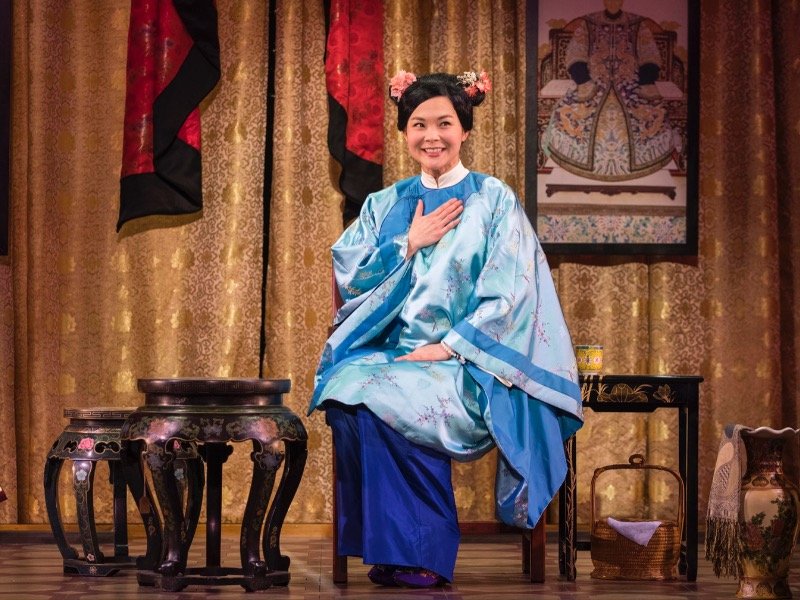She arrived on New York shores from Canton, China, by boat in 1834 at the age of only 14. Being the first Chinese immigrant to arrive in the U.S., Afong Moy was immediately put to work as a living exhibition – price of admission 25 cents, 10 cents for children. Her stage name was, amazingly enough, "The Chinese Lady." Moy’s experience was never officially documented or told, until now.
The glass case where Afong Moy spent roughly 55 years displayed with various "other Chinese curiosities" is the one and only setting for director May Adrales’ play, currently on stage at the Milwaukee Rep. Written by Lloyd Suh, "The Chinese Lady" is not about a woman educating viewers about Chinese culture, but enlightening them about their own history and giving a woman, who never before had a voice, the platform she’s earned to shout the uncomfortable truth.
Glossy red silks rise like magic to reveal red lanterns, framed photos of Chinese emperors, golden vases and, dressed in tiny purple shoes and oriental clothing, a beautiful Chinese lady.
"It’s human nature to be curious," says Moy at the show’s start, seated in her antique chair as she gazes into the fictitious heavens. "My feet seem to be of particular interest to people."
Making her Milwaukee debut, Lisa Helmi Johanson plays the character of Alfong Moy. With bright eyes to match her character’s wide smile, Johanson sets the scene perfectly as she melts into the role of an innocent young girl, enchanted by her American onlookers and naive to the cruelties her caged life has in store.
It’s easy to be drawn into the first 40 minutes of this production, with humorous exchanges between Moy and her translator Atung (played by Jon Norman Schneider) on the intricacies of Chinese culture. From comparing chopsticks and the "violent but easy" fork, to Moy’s lengthened teasing of tea slurping, "The Chinese Lady" starts out saturated in humor. But slowly, deeper messages start to seep through the cracks of her confinement.
"Dipped in herbs and animal blood, oiled, then broken before being bound," is how Johanson’s character describes the process of feet binding. Despite her remaining smile, it’s the first of many eye-opening monologues to come from Moy through the pages of Suh’s script, now brought to thought-provoking life.
Though subjects of The Opium War, the Chinese Exclusion Act and disheartening exchanges with Andrew Jackson are interlaced with Moy’s fascination with American city names like Pittsburgh, the liberty bell and her proud heritage, the brightness in Johanson’s eyes fades as her character grows wiser.
With each drawing of the curtain, signifying the passing of time in Moy’s life, the topics mature as the Chinese lady herself ages. Atung monologues in the play, "All humans have an appetite for the things they cannot have," desiring to possess a spirit that is not theirs to own. Suh’s script suggests there’s a line between harmless curiosity and the captivity of observing animals in a cage or so-called "freakshows" on a circus stage.
"If I am in a cage, what animal am I?" asks Moy to a spotlighted and silent audience.
Challenging the structures and rituals that have created a false sense of security in American culture is the backbone of this production, as is the raw emotion that comes pouring out of Johanson is nearly every scene. Both Schneider and Johanson’s characters become more serious and captivating as the story goes on, highlighting themes of youth ignorance, American entitlement and cultural connections that have been lost in translation.
"The Chinese Lady" is 90 minutes long with no intermission, not that it’s needed. While the play’s witty humor first pulls audiences in, it’s the disturbing and heart-wrenching story of Moy’s experiences with the New York museum and PT Barnum that causes viewers to stay.
Stiemke Studio’s black box challenges audiences to not "sit back and relax" but lean forward and engage as "The Chinese Lady" questions why we look at her and how we observe one another. Eventually, the lines begin to blur between the observed and the observer, showing Moy is no longer "The Chinese Lady" but the fresh eyes with which we view our own history.







